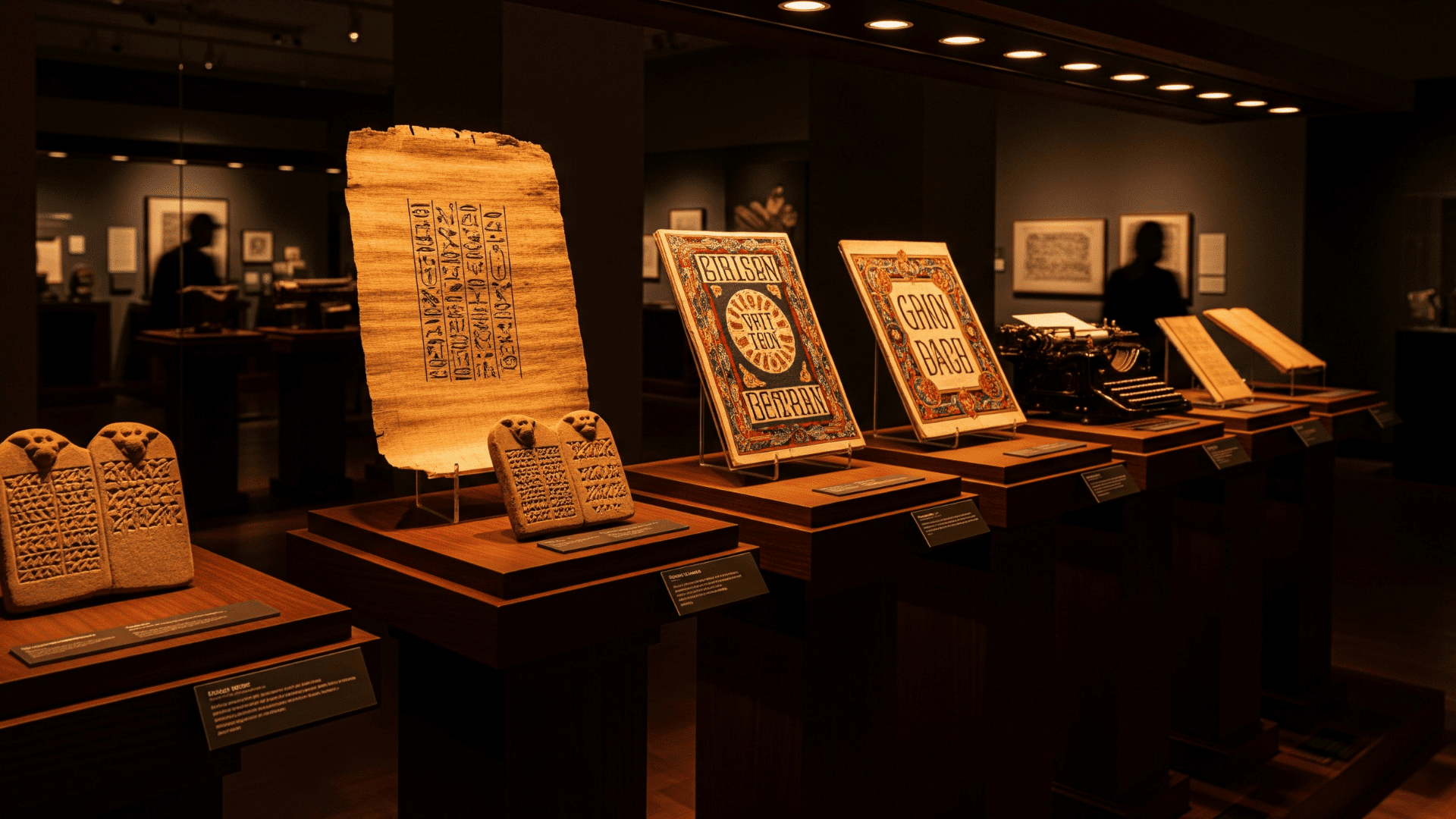Did you know the longest sentence in literature spans over 4,000 words?
That marathon sentence is just the tip of the iceberg when it comes to writing’s wild side. Writing isn’t just a craft; it’s a remarkable world packed with bizarre historical moments, quirky cultural traditions, and mind-bending psychological tricks that most people never suspect.
From the peculiar origins of punctuation marks to the secret ways different writing tools actually change your creativity, the written word is bursting with surprises that’ll make you look at every page differently.
Ready to uncover the delightfully strange secrets hiding behind humanity’s most essential skill?
Before We Begin: A Look at the Power of Writing
Think about it: with just 26 letters, we’ve built entire civilizations, sparked revolutions, and made people fall in love with characters who never existed. Writing is humanity’s ultimate magic trick: turning squiggly marks into laughter, tears, and “aha!” moments.
Every great idea, every scientific breakthrough, every story that’s ever moved you started with someone staring at a blank page. It’s the bridge between what’s rattling around in one person’s head and what ends up changing the world.
So let’s peek behind the curtain and see what makes this everyday miracle tick.
Historical Evolution of Writing
1. The earliest writing system, cuneiform, emerged around 3400 BCE in Mesopotamia and was initially used for accounting.
2. Ancient Egyptian hieroglyphics contained over 700 symbols, with some representing sounds and others representing words or concepts.
3. The Chinese writing system has remained consistent for over 3,000 years, allowing modern readers to understand texts from centuries ago.
4. The first known author was a woman, “Enheduanna”, a Sumerian priestess who wrote hymns and poems around 2300 BCE.
5. Before the invention of spaces between words (scriptura continua), ancient Greek and Roman texts were written as continuous blocks.
6. Punctuation wasn’t standardized until the 16th-17th centuries, with the printing press driving the need for consistency.
7. The “ampersand (&)” was once considered the 27th letter of the English alphabet.
8. In medieval Europe, parchment was so valuable that monks would scrape off old texts to reuse the material (creating palimpsests).
9. The world’s oldest newspaper, Post-och Inrikes Tidningar from Sweden, began in 1645 and is now published exclusively online.
10. The first crossword puzzle appeared in the “New York World” newspaper in 1913, created by journalist Arthur Wynne.
11. Before the invention of the ballpoint pen in the 1940s, fountain pens required constant refilling and often leaked, making writing potentially messy.
Writer’s Wisdom: When facing writer’s block, study the evolution of writing to remember you’re part of an ancient tradition that has constantly reinvented itself through challenges and technological shifts.
The Psychology of Writing
12. The act of writing by hand activates regions in the brain that typing doesn’t, potentially improving learning and idea generation.
13. Studies show that writing about traumatic or emotional experiences (expressive writing) can improve physical and mental health outcomes.
14. The “flow state” experienced by writers shares neurological similarities with meditation, potentially explaining why time seems to disappear during intense writing sessions.
15. Our brain processes stories differently than other information, releasing oxytocin (the bonding hormone) when we read or write emotionally engaging narratives.
16. The average person’s working memory can only hold about 7 items at once, which is why complex writing requires outlining and organization.
17. People tend to write more creatively when slightly tired, as fatigue can reduce inhibitions and logical constraints on thinking.
18. Writing daily goals down on paper increases the likelihood of achieving them by 42% compared to just thinking about them.
19. People remember information better when they’ve written it down rather than typed it, a phenomenon known as the “generation effect.”
20. Writing in blue ink has been shown to stimulate creativity, while red ink increases attention to detail.
21. A Cornell University study found that writers often don’t recognize errors in their own work because the brain automatically fills in what it expects to see.
22. Bilingual writers often report having different personalities or tones when writing in different languages.
Expert Insight: Create a personalized writing ritual that signals to your brain it’s time to enter the writing mindset: this could be a specific location, background music, or even a particular beverage that becomes associated with productive writing.
Unique Writing Statistics
23. An average pencil can write approximately 45,000 words or draw a line 35 miles long before it’s used up.
24. The world’s fastest typist, Barbara Blackburn, maintained a speed of 212 words per minute for 50 minutes and peaked at 216 wpm.
25. The English language has approximately 171,476 words currently in use, with new words being added constantly.
26. The longest novel ever published is “Artamène ou le Grand Cyrus” by Madeleine de Scudéry, containing about 2.1 million words.
27. The world record for the most books written by one person belongs to L. Ron Hubbard, with 1,084 published works.
28. Stephen King typically writes 2,000 words per day, every day, including holidays and birthdays.
29. The Dvorak Simplified Keyboard, designed in the 1930s, was created to increase typing speed and efficiency, but QWERTY remains the global standard.
30. About 55% of the English language comes from Latin and French, 35% from Germanic languages, and 10% from other sources.
31. The most commonly used letter in English is ‘e’, appearing in about 11% of all written words.
32. The word “alphabet” comes from the first two letters of the Greek alphabet, alpha and beta.
33. Approximately 300 million pens are sold in the United States every day.
Productivity Pointer: Track your writing output over time to find your natural productivity patterns; some writers produce more in the morning, others at night, and understanding your personal rhythm can dramatically increase your efficiency.
Digital Age Writing Changes
34. The first email was sent in 1971 by Ray Tomlinson, though he doesn’t remember the exact content (likely “QWERTYUIOP” or something similar).
35. The average business professional today writes the equivalent of a novel (50,000+ words) in emails alone each year.
36. Twitter’s original 140-character limit was based on SMS text message limitations, fundamentally changing how people express ideas concisely.
37. Emojis were created in Japan in 1999 by Shigetaka Kurita, who designed the first 176 symbols to allow for emotional nuance in text messages.
38. Predictive text algorithms now influence how we write, with some studies showing they may be homogenizing language usage.
39. The hashtag (#) was proposed for use on Twitter by Chris Messina in 2007, changing how information is categorized online.
40. Over 500 hours of written subtitles/captions are uploaded to YouTube every minute, making it one of the largest text repositories in existence.
41. Digital writing tools have created new forms of collaborative writing, with some novels now written by hundreds of contributors simultaneously.
42. GPT-based language models like those used for assistance in writing were trained on more text than any human could read in thousands of lifetimes.
43. Software that analyzes writing can now predict psychological traits, education level, and even certain medical conditions based on writing patterns.
44. The average reading level of viral web content has dropped from 10th grade to 6th grade level over the last decade.
Technique Tip: When writing for digital audiences, remember the F-pattern eye tracking studies; readers typically scan in an F-shape, so put your most important information in the first two paragraphs and at the beginning of subheadings.
Strange and Surprising Writing Facts
45. The longest English word without a repeated letter is “uncopyrightable” (15 letters).
46. The semicolon was originally invented to denote a pause between independent clauses, not to wink in text messages.
47. “I am.” is the shortest complete sentence in English.
48. The longest published sentence in English literature contains 13,955 words in Victor Hugo’s “Les Misérables.”
49. The fear of blank paper or writer’s block is called “scriptophobia.”
50. A group of writers is collectively known as a “worship” of writers.
51. Shakespeare invented approximately 1,700 words still used in English today, including “assassination” and “eyeball.”
52. The dot over the letters ‘i’ and ‘j’ is called a “tittle.”
53. The QWERTY keyboard layout was designed to slow typists down to prevent mechanical typewriter jams.
54. The first documented emoticon (a sideways smiley face) was used by Scott Fahlman in 1982 in a computer science forum.
55. “Buffalo buffalo Buffalo buffalo buffalo buffalo Buffalo buffalo” is a grammatically correct sentence in American English.
Insider Trick: When stuck on a writing problem, change your physical position completely; research shows that altering your body posture can trigger new neural pathways and problem-solving approaches.
Final Thoughts
Who knew that scribbling words could be such a wild ride? From those first cave painters to today’s emoji-filled texts, we’ve been on an incredible exploration of human expression that’s far weirder and more wonderful than most people realize.
The next time you pick up a pen or start typing, remember you’re wielding one of humanity’s most powerful inventions. You’re part of a tradition that spans millennia, taps into your brain’s hidden superpowers, and continues evolving faster than ever.
So go ahead; write something amazing. The world is waiting for your unique voice to join this endless, ever-changing conversation.

























